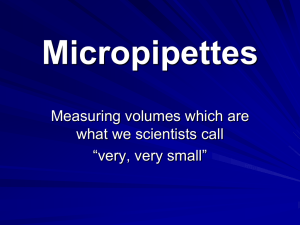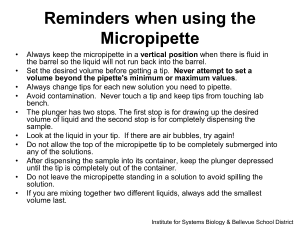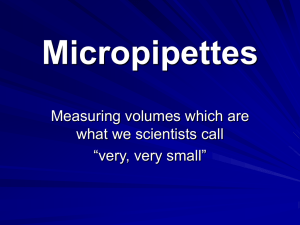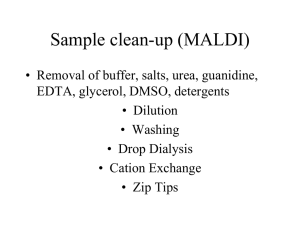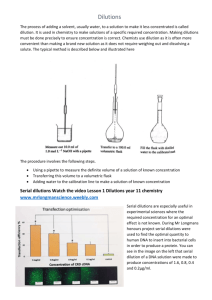Dilutions & Micropipettes: Lab Calculations & Techniques
advertisement
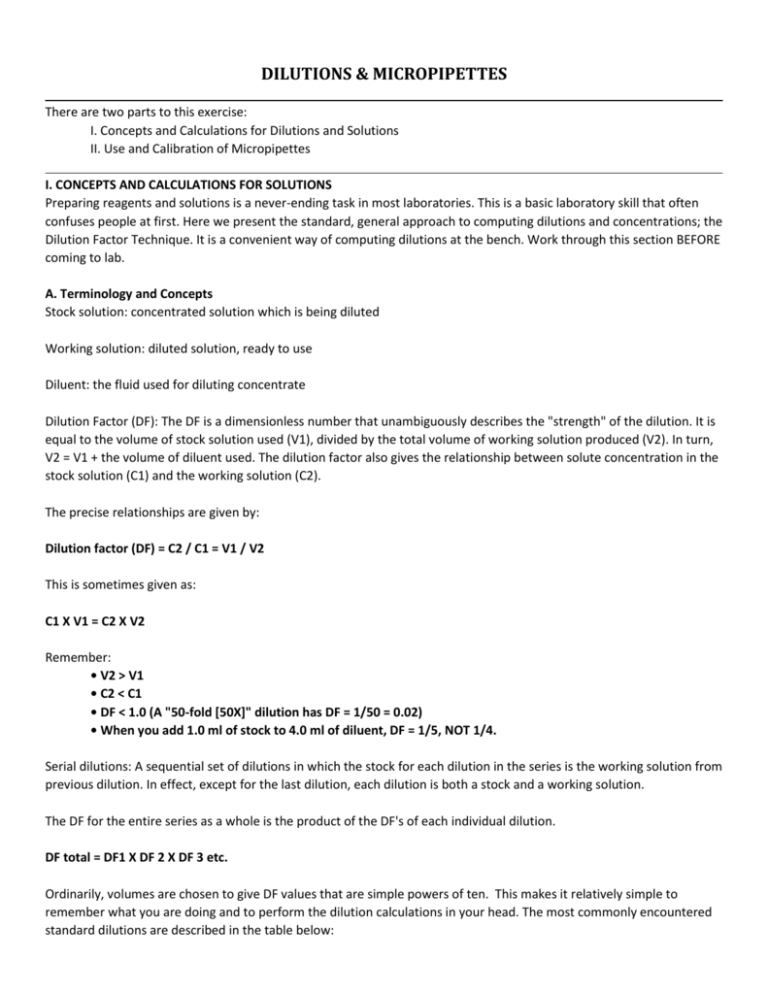
DILUTIONS & MICROPIPETTES There are two parts to this exercise: I. Concepts and Calculations for Dilutions and Solutions II. Use and Calibration of Micropipettes I. CONCEPTS AND CALCULATIONS FOR SOLUTIONS Preparing reagents and solutions is a never-ending task in most laboratories. This is a basic laboratory skill that often confuses people at first. Here we present the standard, general approach to computing dilutions and concentrations; the Dilution Factor Technique. It is a convenient way of computing dilutions at the bench. Work through this section BEFORE coming to lab. A. Terminology and Concepts Stock solution: concentrated solution which is being diluted Working solution: diluted solution, ready to use Diluent: the fluid used for diluting concentrate Dilution Factor (DF): The DF is a dimensionless number that unambiguously describes the "strength" of the dilution. It is equal to the volume of stock solution used (V1), divided by the total volume of working solution produced (V2). In turn, V2 = V1 + the volume of diluent used. The dilution factor also gives the relationship between solute concentration in the stock solution (C1) and the working solution (C2). The precise relationships are given by: Dilution factor (DF) = C2 / C1 = V1 / V2 This is sometimes given as: C1 X V1 = C2 X V2 Remember: • V2 > V1 • C2 < C1 • DF < 1.0 (A "50-fold [50X]" dilution has DF = 1/50 = 0.02) • When you add 1.0 ml of stock to 4.0 ml of diluent, DF = 1/5, NOT 1/4. Serial dilutions: A sequential set of dilutions in which the stock for each dilution in the series is the working solution from previous dilution. In effect, except for the last dilution, each dilution is both a stock and a working solution. The DF for the entire series as a whole is the product of the DF's of each individual dilution. DF total = DF1 X DF 2 X DF 3 etc. Ordinarily, volumes are chosen to give DF values that are simple powers of ten. This makes it relatively simple to remember what you are doing and to perform the dilution calculations in your head. The most commonly encountered standard dilutions are described in the table below: B. EXAMPLES 1. Given a stock of 32% w/v NaCl, how would you make 500 ml of 5.6% w/v NaCl? • DF = C2 / C1 = 5.6/32 = 0.175 • V1 = DF X V2 = 0.175 X 500 ml = 87.5 ml • Add 87.5 ml NaCl stock to 412.5 ml water. 2. How would you make 100 ml of 32% w/v NaCl? (Note: A 1% w/v solution contains 1 g of solute in a volume of 100 ml). • Weigh 32.0 g NaCl on a balance. • Add enough water to give a final volume of 100 ml. (This will be less than100 ml!) 3. You have a stock solution of 20X TAE Buffer. “20X” refers to the solute concentration of the stock relative to the final “working concentration”. How would you prepare 1 liter of TAE Buffer at working concentration (1X) from the20X TAE stock? • DF = C2 /C1 = 1X/20X = 0.05 • V1 = DF X V2 = 0.05 X 1,000 ml = 50.0 ml • Measure 50.0 ml of the 20X stock solution and add enough water to give afinal volume of 1 liter. (The approximate volume of water will be 950 ml.) 4. How much of a 20 mg/ml stock solution of ampicillin would you need to add to1 liter of bacterial growth medium to achieve a final concentration of 100µg/ml ampicillin? • DF = C2 / C1 = 100 µg/ml / 20,000 µg/ml = 5 X 10-3 • V1 = DF X V2 = 5 X 10-3 X 1,000 ml = 5.0 ml • Add 5.0 ml ampicillin stock to 1 liter medium. 5. You have 1.0 ml of bovine serum albumin (BSA) at a concentration of 10mg/ml. You want 1.0 ml of BSA at a concentration of 10 ng/ml. Describe the procedure you would use to dilute your sample to 10 ng/ml. Careful. This is not as straightforward as it appears. Remember that you cannot measure volumes less than 1 µl accurately; therefore a serial dilution is used. • DF = C2 /C1 = 10 ng/ml / 107 ng/ml = 10-6 • V1 = DF X V2 = 10-6 X 1,000 µl = 10-3 µl • Add 10-3 µl stock to 1.0 ml water. • The problem we see with this method is that there is no convenient way to measure 10-3 µl accurately. • Instead, you should perform a series of standard dilutions. For example, could do a series of three consecutive 10-2 dilutions to reach a total dilution of 10-6. C. Exercises 1. Fill in the blank spaces with the appropriate value. See Appendix A.7 for the definitions of unit prefixes in the metric system. 10 mM = _______ M 1 µM = _________ M 1 liter = _________ ml 0.1 ml = _______ µl 10 mg = _________ g 10 µg = _________ g 2. Describe how you would prepare 200 ml of a 0.25 M solution of NaOH (molecular weight = 40 g/mol). 3. “Physiological” saline is a solution of 0.85% (weight/volume) NaCl that is isotonic with tissue. Describe how you would prepare 1 liter of physiological saline. (Remember that 1% w/v is equivalent to 1 g/100 ml.) 4. Calculate how much glycerol you would need to make 200 ml of a 20% (v/v) glycerol solution. (Glycerol is a liquid.) 5. Describe how you would prepare 125 ml of a 0.8% w/v agarose in 1X TAE buffer starting with a 20X TAE stock solution and solid agarose powder. 6. If a 100X solution is 1 M, what is the concentration of a 1X solution? 7. The following problem is derived from a notorious article in a prestigious journal. [Davenas, E. et al. (1988) Nature 333, 816-818.]. Solutions containing a specific antibody cause a response called “degranulation” when the antibody solution is mixed with a suspension of human leukocytes (white blood cells). Degranulation is part of the normal immunologic response of the leukocytes to the presence of foreign antigens. In an assay for degranulation, 1.5 ml of the antibody solution is mixed with 30 µl of leukocyte cell suspension and then the cells are examined using a microscopic to determine whether or not degranulation has occurred. The article in Nature reported the following experimental observation based on the degranulation assay described above: A solution of antibody antibody at a concentration of 2 X 10–9 M causes the degranulation response. When the 2 X 10–9 M antibody solution was diluted by a factor of DF = 10–100, the degranulation response still occurred. Why do you think this claim evoked expressions of astonishment worldwide? Evaluate the result using the ability to perform dilution series calculations and suggest why it was met with incredulity. (HINT: Avagadro’s number is 6.02 X 1023 molecules/mole.) II. USE AND CALIBRATION OF MICROPIPETTES Take nothing for granted, least of all the equipment you rely on. Micropipettes are indispensable tools in modern biology laboratories. How accurate are yours? How precise are yours? What is the difference between accuracy and precision? Find out. Accuracy refers to performance with respect to a standard value. Precision refers to the reliability or repeatability of performance and doesn’t necessarily depend on a standard at all. These two features are independent of each other. It is possible (and not so unusual) to have an instrument that is precisely inaccurate (or accurately imprecise)! Confused? Perhaps the following diagram will help. To simultaneously evaluate the accuracy and precision of your pipettes you must conduct multiple measurements and compute the % Error Of The Mean and Standard Deviation of the measurements for each pipette. A. Directions for use of Gilson Pipettes Gilson micropipettes are virtually ubiquitous in research labs. You have 3 sizes of micropipette. The P-1000, the P-200 and the P-20. The model numbers refer to the maximum volume in microliters. Initially you will need to puzzle out which pipette to use in a given circumstance. For example, if you are told to transfer 0.18 ml you would probably need to use the P-200 because 0.18 ml = 180 ul and because the P-200 will measure this volume with greater accuracy and precision than the P-1000 will. Generally, you choose the smallest volume pipette that will transfer the entire volume. What would you do if told to measure 1.20 ml? These pipettes are not toys. They are top of the line, expensive equipment and you must use them responsibly. Here are a few simple rules. Rules: • Always use a disposable tip. The P-20 and P-200 use the yellow tips and the P1000 uses blue ones. Never draw any fluid into the white barrel of the pipette itself. • Never lay a pipette down while there is fluid in the tip. The fluid may accidentally find its way into the barrel. • Never turn the adjustment scale below or above the full range settings. • To maximize precision, Always use the smallest volume pipette and tube for agiven total volume. 1. Set the desired volume. Turn the volume up just a tiny bit past the desired setting, then down. 2. Attach a tip. Press it on firmly, with a slight twisting motion. The tip must make an air-tight seal with the pipette barrel. 3. Depress the plunger to first stop. Most people operate the plunger with their thumb. 4. Insert the tip in the liquid you want to transfer. Not far, just a bit below the surface. 5. Release plunger SLOWLY. Releasing the plunger suddenly may cause the pipette to under fill. Also, be aware that the liquid level in the tube will drop as you withdraw fluid. Make sure that it doesn't drop below the level of the tip or you will suck air. 6. As you withdraw the tip, touch it to the side wall of the tube to remove excess fluid from the exterior. 7. To dispense, depress plunger slowly to the first stop; hesitate; then depress all the way. When pipetting viscous solutions (such as restriction enzyme stocks) it is advisable to rinse the tip by pipetting the solution up and down once or twice. One of the most common problems for the beginner is the tendency of small liquid volumes to adhere to the pipette tip rather than dispensing into the tube. Never dispense a small volume into thin air. Always dispense into a liquid or onto the wall of a tube so that adhesion will draw the expelled liquid off the tip. Unfortunately, this may mean that the tip is contaminated and cannot be reused. 8. With the plunger still fully depressed, remove tip from the liquid. 9. Think about what to do with the pipette tip. Should you discard it, or use it again? "If in doubt, throw it out." B. Directions for checking pipette calibration. Each member of a pair should complete the pipette calibration independently using the same pipettors. Remember that 1.0 milliliter of distilled water weighs 1.0 gram at 25°C. Ideally the calibration should be checked at several at points throughout its range. To save time we will check the calibration at the maximum setting only. It is ideal to use an electronic analytical balance that is accurate to the nearest 0.1mg. Accuracy to the nearest 1.0 mg is sufficient for checking the P-1000 and P-200,but not the P-20. (For an analysis of the way balance precision affects your calibration see the web site.) The data and results of this calibration exercise are best recorded and presented in a TABLE. We provide these tables as an example. In subsequent exercises you will create your own tables. This is something you should do BEFORE coming to lab whenever possible. For your P200 micropipette: 1. Use a strip of Parafilm or a plastic weighing boat on the balance pan. 2. Set the balance to zero. (The zero button may be labeled “tare”). 3. Set the pipette to its maximum volume and attach a tip. 4. Dispense the water onto the balance and record the balance reading. 5. Repeat step 4. until you have a total of five readings. 6. Compute the MEAN, the % ERROR of the MEAN and the STANDARD DEVIATION of the 5 readings. Assume 1.0 ml of water weighs 1.0 g. The standard deviation is: where “X” is each individual value, “X-bar” is the average of all values, and (X“n” is the number of values). C. Data Sheet D. Questions for Discussion How much inaccuracy and imprecision are acceptable, do you think? Compare to the manufacturer's specifications given below. The accuracy and precision of the measurements are affected by the micropipette AND by your technique. Can you devise a way to test the relative contributions of pipette error and operator error to total error? Does the % Error Of The Mean tell you about accuracy, or precision? Does the Standard Deviation tell you about accuracy, or precision? E. A Test Here are two quick tests of your ability to operate the pipettors. • Use a P1000 to add 0.5 ml of H2O to a microfuge tube. Set the P200 to 100 µl and withdraw the entire 0.5 ml. • Use a P200 to add 0.05 ml of di H2O to a microfuge tube. Set the P20 to 10 µl and withdraw the entire 0.05 ml.
